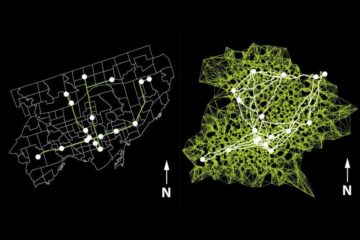Tyler Irving in Phys.Org:
 It doesn’t have a brain and survives on rotting vegetable matter—but it could offer valuable insights into city planning, according to a team of University of Toronto researchers. Physarum polycephalum is a slime mold, a single-celled amoeboid organism that grows as a greenish-yellow system of veins. These veins form a tubular network that is optimized to transfer nutrients efficiently throughout the entire organism.
It doesn’t have a brain and survives on rotting vegetable matter—but it could offer valuable insights into city planning, according to a team of University of Toronto researchers. Physarum polycephalum is a slime mold, a single-celled amoeboid organism that grows as a greenish-yellow system of veins. These veins form a tubular network that is optimized to transfer nutrients efficiently throughout the entire organism.
Slime molds first “forage” broadly over an area, then refine their tubular network to optimize for transport of the nutrients. Now, researchers believe the slime mold’s efficient organic structure could provide a model for optimizing other networks—including those designed to move people and goods around a city.
More here.
